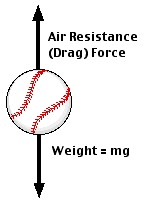Surely this bird must be from another world for this to be possible...
Okay I misled you. I will ask a more relevant question. If you dropped a feather and a bowling ball from a height, at the same time - what would you expect? You would expect the bowling ball to hit the floor a lot faster than the feather. Let's discuss.

We must talk about the not so interesting fundamentals of what is going on here to move on to more spectacular things so bear with me, It will be quick.
Newton's second law states that the force on an object is its mass times by its acceleration (F = ma).
When an object is falling it has certain forces acting on it. In free-fall, there are two. Its weight; F = mg (mass x gravity), which pulls the object down towards Earth, and air resistance which resists the force of the weight by acting against it.

Figure 1: Image showing ball with labelled forces mentioned above
If the object is falling the result of the weight and the air resistance is the force F = mg, so...
Since the overall force of an object is F = ma and F = mg, we can set these two equal to each other (since they are effectively the same thing). We get: ma = mg
We see that the masses cancel out so we have a = g, which is an interesting result. This means that when an object is falling its acceleration does not depend on the mass of the object, and that the acceleration is only due to gravity.

Suppose we could remove all air resistance, i.e. produce a vacuum (which would do the trick). What would we expect if we drop a very heavy object (bowling ball) and a very light object (feather) at the same time, in a vacuum.
If our calculations are correct they should fall at the same time since the object's masses don't matter in free-fall.
Play this video and skip to 2:50 to see for yourself.

